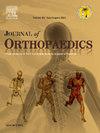病态肥胖对反向全肩关节置换术术后结果的影响:一项全国住院患者样本分析
IF 1.5
Q3 ORTHOPEDICS
引用次数: 0
摘要
反向全肩关节置换术(rTSA)是一种广泛应用于肩袖关节病的手术,适应症扩大到包括骨折、骨关节炎和翻修关节置换术。肥胖是关节置换术中的重大挑战,但病态肥胖(BMI≥40 kg/m2)对rTSA结果的影响仍未得到充分探讨。本研究使用一个大型数据库来检查rTSA患者的病态肥胖与围手术期预后之间的关系。方法采用2016 - 2019年国家住院患者样本(NIS)数据库进行回顾性队列研究。年龄≥18岁接受rTSA治疗的患者被分为病态肥胖(病态-肥胖(+))和非病态肥胖(对照组)两组。结果分析包括人口统计学因素、住院时间(LOS)、出院处置和术后并发症。采用卡方检验、独立t检验和多变量逻辑回归进行统计分析,以评估相关性。结果纳入4850例病态肥胖(+)患者和55075例对照组。发病率-肥胖(+)组更年轻(平均年龄:67.74 vs. 71.67岁;p & lt;0.001),并且更有可能来自少数群体,特别是黑人患者(7.71% vs. 3.94%;p & lt;0.001)。他们的LOS明显更长(平均:2.23天vs. 1.87天;p & lt;0.001)和更高的排放到非常规设施的比率。主要并发症在病态-肥胖(+)队列中更为常见,包括假体周围脱位(2.60% vs 1.59%;OR 1.65, p <;0.001),深静脉血栓形成(0.17% vs. 0.07%;OR 2.27, p = 0.03),失血性贫血(11.61% vs. 10.12%;OR 1.17, p <;0.001),急性肾衰竭(3.53% vs. 2.11%;OR 1.69, p <;0.001)。结论肥胖与rTSA患者较高的并发症发生率、住院时间延长和非常规出院率增加有关。这些发现强调了在这一高危人群中进行量身定制的术前计划和术后管理的必要性。本文章由计算机程序翻译,如有差异,请以英文原文为准。
Impact of morbid obesity on postoperative outcomes in reverse total shoulder arthroplasty: A national inpatient sample analysis
Introduction
Reverse total shoulder arthroplasty (rTSA) is a widely used procedure for rotator cuff arthropathy, with indications expanding to include fractures, osteoarthritis, and revision arthroplasty. Obesity poses significant challenges in arthroplasty, yet the impact of morbid obesity (BMI ≥40 kg/m2) on rTSA outcomes remains underexplored. This study examines the association between morbid obesity and perioperative outcomes in rTSA patients using a large database.
Methods
We conducted a retrospective cohort study using the National Inpatient Sample (NIS) database from 2016 to 2019. Patients aged ≥18 years who underwent rTSA were stratified into morbidly obese (Morbid-Obesity (+)) and non-morbidly obese (Control) cohorts. Outcomes analyzed included demographic factors, length of stay (LOS), discharge disposition, and postoperative complications. Statistical analyses were performed using chi-squared tests, independent t-tests, and multivariate logistic regression to assess associations.
Results
The study included 4850 Morbid-Obesity (+) patients and 55,075 Control patients. The Morbid-Obesity (+) cohort was younger (mean age: 67.74 vs. 71.67 years; p < 0.001) and more likely to be from minority groups, particularly Black patients (7.71 % vs. 3.94 %; p < 0.001). They had significantly longer LOS (mean: 2.23 vs. 1.87 days; p < 0.001) and higher rates of discharge to non-routine facilities. Major complications were more common in the Morbid-Obesity (+) cohort, including periprosthetic dislocation (2.60 % vs. 1.59 %; OR 1.65, p < 0.001), deep vein thrombosis (0.17 % vs. 0.07 %; OR 2.27, p = 0.03), blood loss anemia (11.61 % vs. 10.12 %; OR 1.17, p < 0.001), and acute renal failure (3.53 % vs. 2.11 %; OR 1.69, p < 0.001).
Conclusions
Morbid obesity is associated with higher complication rates, prolonged hospital stays, and increased non-routine discharge rates in rTSA patients. These findings underscore the need for tailored preoperative planning and postoperative management in this high-risk population.
求助全文
通过发布文献求助,成功后即可免费获取论文全文。
去求助
来源期刊

Journal of orthopaedics
ORTHOPEDICS-
CiteScore
3.50
自引率
6.70%
发文量
202
审稿时长
56 days
期刊介绍:
Journal of Orthopaedics aims to be a leading journal in orthopaedics and contribute towards the improvement of quality of orthopedic health care. The journal publishes original research work and review articles related to different aspects of orthopaedics including Arthroplasty, Arthroscopy, Sports Medicine, Trauma, Spine and Spinal deformities, Pediatric orthopaedics, limb reconstruction procedures, hand surgery, and orthopaedic oncology. It also publishes articles on continuing education, health-related information, case reports and letters to the editor. It is requested to note that the journal has an international readership and all submissions should be aimed at specifying something about the setting in which the work was conducted. Authors must also provide any specific reasons for the research and also provide an elaborate description of the results.
 求助内容:
求助内容: 应助结果提醒方式:
应助结果提醒方式:


